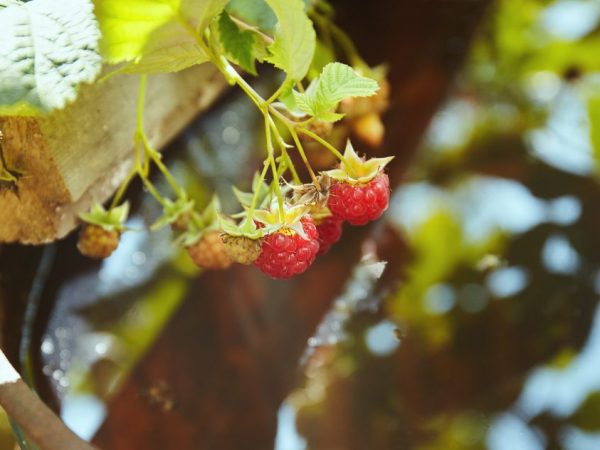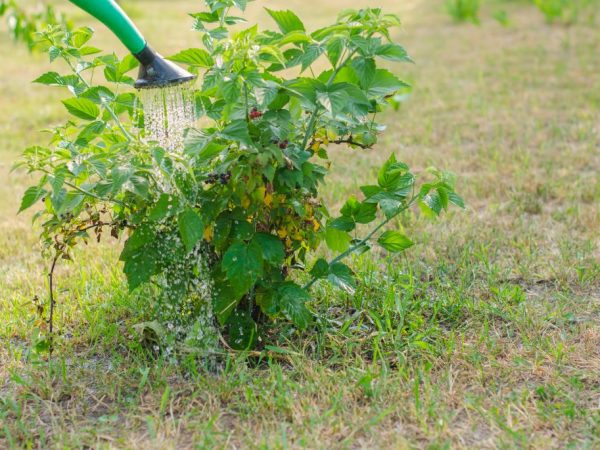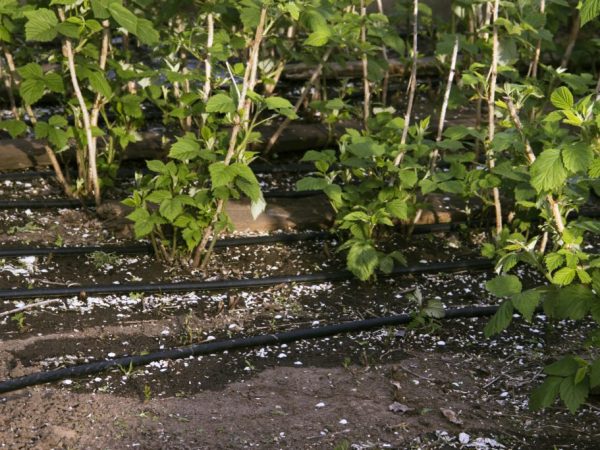How to feed raspberries in the fall - which fertilizer to choose
Feeding raspberries in the fall is a must. Novice gardeners needlessly ignore it - without proper care and preparation of the bush for winter, there will be no good harvest for the next season. Consider when and what fertilizers to use so that the culture can resist frost and bear fruit abundantly.

How to feed raspberries in the fall - which fertilizer to choose
Purpose of the procedure
Raspberry bushes have a well-developed root system, through which they extract nutrients from the soil, which are especially necessary at the stage of awakening in spring, flowering and active fruiting.
Without the replenishment of useful components, the soil becomes less fertile, without timely fertilization, the yield will decrease.
At the end of the summer season, the fruit and berry culture uses almost all the necessary elements introduced during the growing season, and without additional nutrition, it is vulnerable to the coming winter cold.
When planning feeding, they are guided by the external state of the plants:
- pay attention to the color and size of the foliage;
- correlate the number of berries and shoots;
- analyze the strength of the branches.
Small, rapidly yellowing leaves combined with weak shoots indicate a lack of nutrition.
Well-developed shoots in combination with a small berry yield indicate an excess of nitrogen.
Terms of introduction
Fertilizer for raspberries in the fall should be done twice:
- at the end of the fruiting stage, after harvest (one month before the onset of the rainy period) - this usually occurs in August;
- 2 months before the arrival of cold weather, at the end of September - October.
The growing region directly affects the top dressing rock:
- for the Far East - the last third of August - the first week of September;
- for Eastern Siberia - the first two weeks of September;
- for Western Siberia - 1-3 weeks of September;
- for the Urals - the second half - the end of September;
- for the North Caucasus - end of September-first half of October;
- for the Central strip and the Moscow region - from the second half to the end of September.
Types of feeding
At the end of fruiting, raspberries especially need phosphorus and potassium.
These ingredients will help the fruit and berry culture to accumulate strength and increase frost resistance:
- phosphorus strengthens the immune system and stimulates the development of the root system, its deficiency is replenished in the fall, so that the activity of the component processed during the winter is activated by the spring;
- potassium improves metabolic processes and increases frost resistance.
In autumn, the use of nitrogen-containing complexes is reduced to a minimum, because this component leads to an intensive build-up of green mass, which the plant does not need before winter and lowers the overall resistance to cold.
To replenish the missing elements, they are fed with ready-made mineral preparations and organic matter. They contain equally useful substances, but organic compounds have the advantage of being much longer.
The best feeding option is to alternate seasons, but this does not contradict the simultaneous use of both types of fertilizers.
Organic

Organic fertilizers improve soil quality
The natural base acts not only as additional nutrition for raspberries in the fall, but also restores the soil that has lost its fertility, enriches it with the necessary elements and improves its structure.
It is customary to introduce organic components only at the root.
| Time | View | Rules and dosage |
| August - September, separately from the introduction of nitrogen-containing compositions to avoid increased formation of ammonia | Wood ash Reduces acidity and increases friability | Dry ash powder (200 g / 1 m²) is scattered over the ground around the raspberry bushes. A layer of ash is sprinkled on top with earth. A liquid solution is prepared from powder (200 g) and water (10 l), kept for 7 days and watered the bush. Consumption rate - 5 liters per 1 plant. |
| September October | Manure Contains all the main elements, protects the roots from freezing | Fresh manure is used at the rate of 8-10 kg per 1 m². raspberry plantings. |
| Immediately after the end of fruiting - September | Bird droppings Increases productivity | Dry chicken droppings are scattered over the surface of the soil so that, together with precipitation, it enters the inner soil layers. An aqueous solution of 1: 4 is also used. The bushes are watered with it. Consumption rate - up to 2 liters for 1 plant or up to 10 liters for every 2 m² of raspberry plantings. |
| Aug. Sept | Compost Enriches impoverished soil | Applicable only in rotted form. Prepared from weeds, vegetable tops, fallen leaves, spreading them in layers with peat and manure. Consumption rate - 10 kg per 1 m². raspberry plantings. |
| Together with the introduction of the main fertilizer - manure, compost or chicken droppings | Yeast Accelerate organic decomposition processes | 1 kg of fresh cook's yeast / 10 l of water. The ingredients are mixed and a working solution is prepared from 0.5 liters per 10 liters of water. When using dry yeast - 10 g / 10 l of water / 5 tbsp. Sahara. The mixture is kept for 2-3 hours, the working fluid is prepared with water in a ratio of 1: 5 When introduced, there is an active consumption of calcium and potassium by microorganisms, therefore they are combined with complexes containing these elements. |
| Beginning of September | Peat Increases looseness, neutralizes acidity, has a detrimental effect on pathogenic microflora | Dry peat is poured around the bushes. |
Minerals

Complex fertilizer contains all the necessary trace elements
In addition to organic matter, with a shortage of one of the main useful elements, they use mineral compositions.
- Nitrogen is usually fed in order to form buds for the next season, but the dark color of the foliage and shoots indicates that there is plenty of it in the fruit and berry crop.
- The lack of potassium manifests itself in the form of brittle branches and shrinking leaves, which in the fall, with a small amount of phosphorus, becomes a rich, bright lilac-purple color.
| Time | View | Rules and dosage |
| End of August - early September | Nitrogen | Up to 5-10 g per 1 m² of raspberry plantings. |
| September October | Potassium (as monopotassium phosphate) | It is necessary to introduce it into a trench previously dug around the bush with a depth of up to 0.2 m, laying it dry, filling it with soil from above. Dosage - up to 40 g per plant. |
| September | Phosphorus (regular or double superphosphate) | They feed it near the root system, for which they form a ditch up to 0.15 m deep and put dry fertilizer into it, sprinkling it with earth on top. Consumption rate for 1 bush - up to 60 g. |
Some gardeners prefer to fertilize the culture with complexes, which contain all the necessary components at once:
- phosphorus, potassium, ammonium sulfate, 250 g per 5 liters of water per 1 m²;
- zinc sulfate (3 g), magnesium sulfate (5 g) per 5 liters of water per 1 m²;
- wood ash (50 g), superphosphate (50 g) per 1 liter of water per 1 m².
Summing up
Autumn dressing is the basis for proper care of raspberries and a guarantee of a future rich harvest. They help to restore the necessary components spent by the shrub during the summer in the process of growth and fruiting, and also allow the plant to prepare for winter.
Fertilized with mineral complexes and organics. Nutrients are introduced in the recommended dosage in order to prevent oversaturation and harm the fruit and berry culture.


